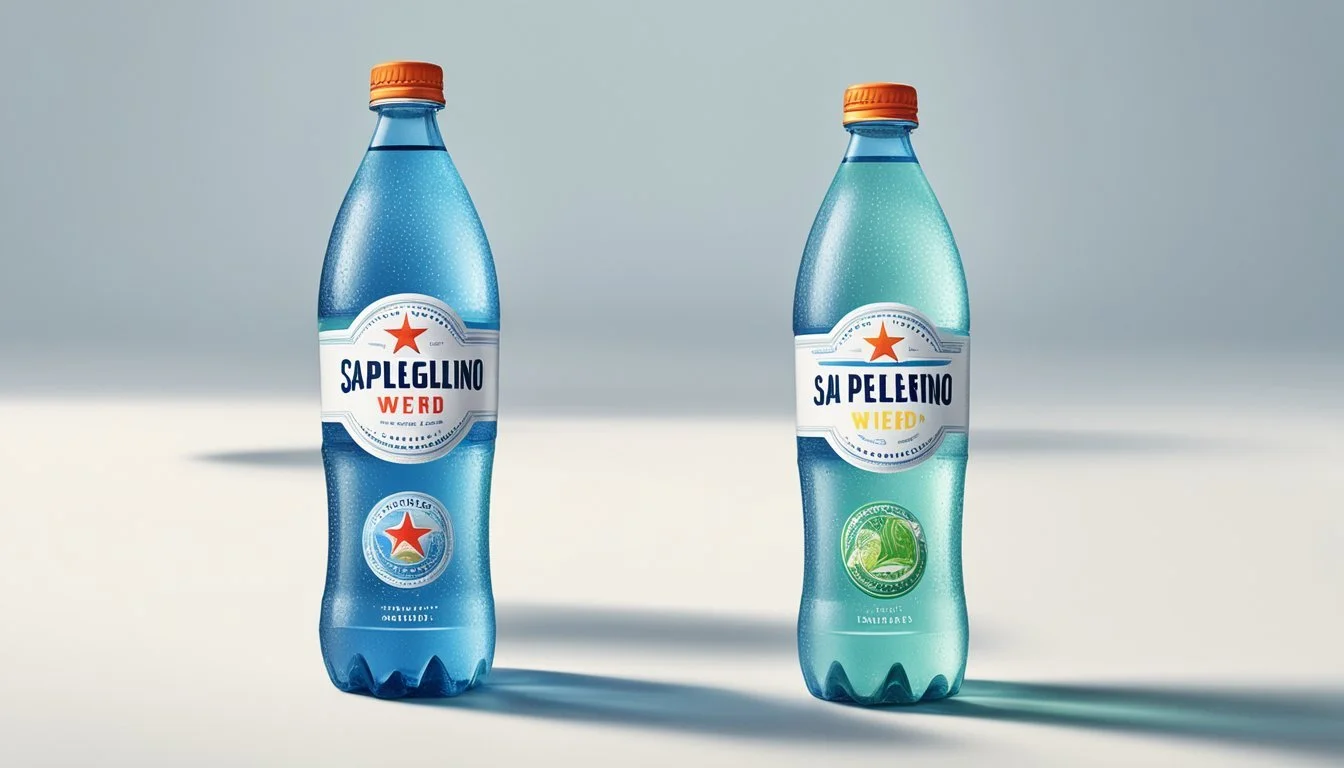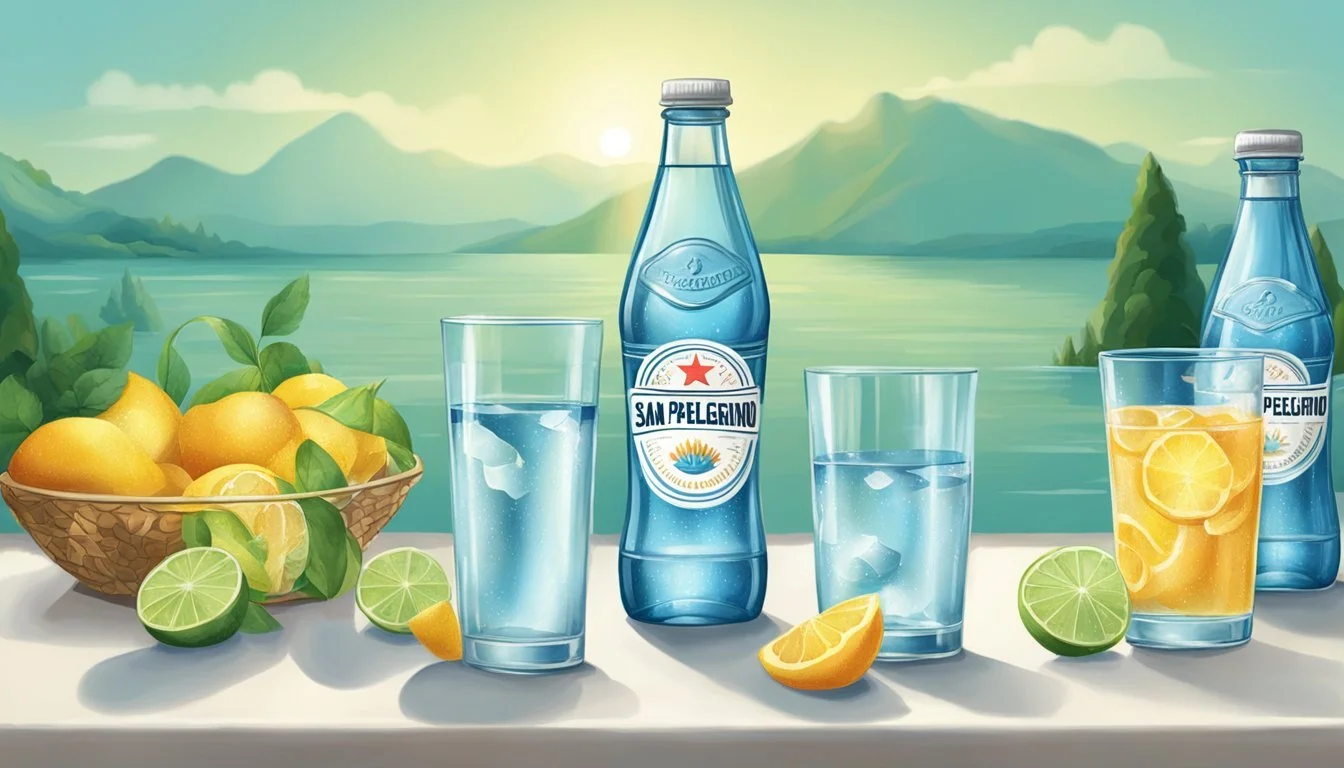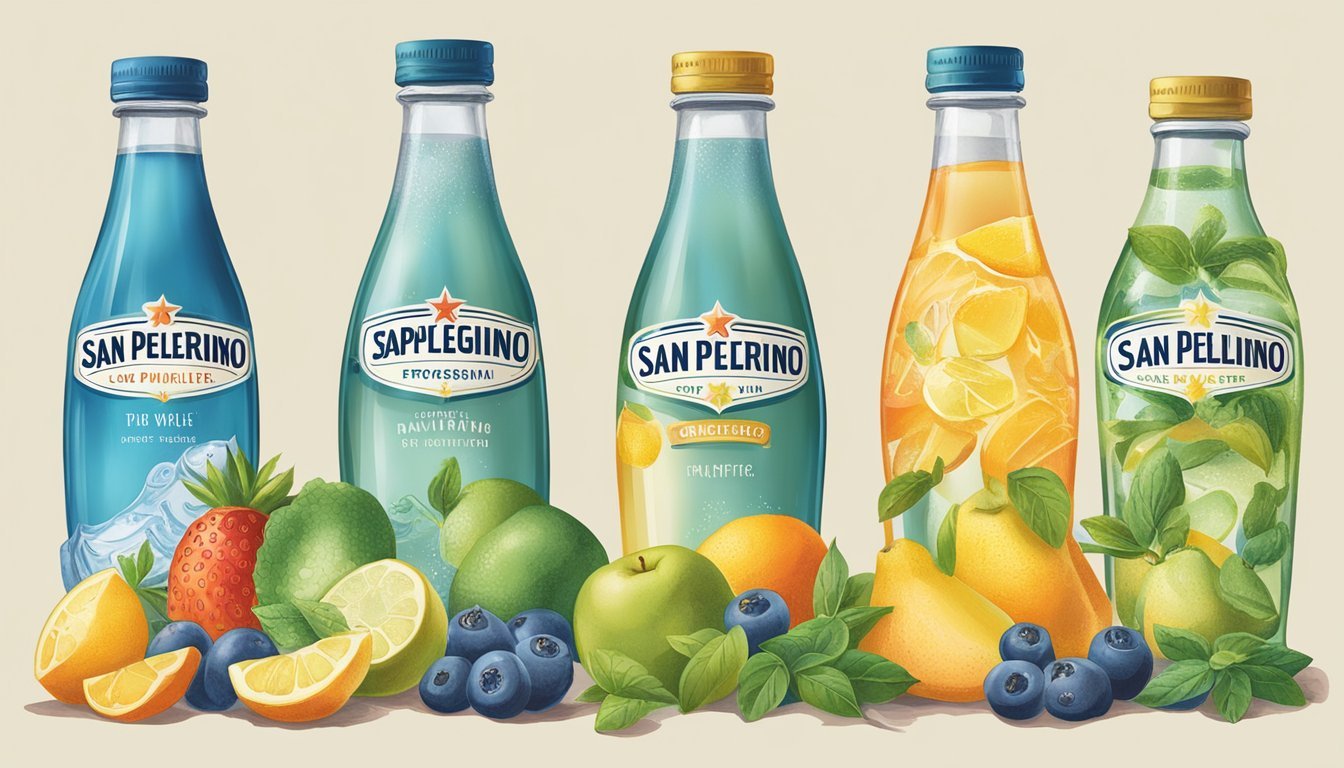San Pellegrino vs. Weird Water
Analyzing Bottled Water Quality
San Pellegrino and Weird Water are two well-known names in the world of bottled water, each offering distinct qualities to the discerning consumer. San Pellegrino, a classic choice, is renowned for its sparkling mineral water. It provides a refreshing fizz that many people find enjoyable and is often associated with luxury and fine dining. On the other hand, Weird Water brings a unique twist to the bottled water market with its intriguing branding and innovative approach.
When it comes to choosing between these two, consumers are often swayed by the unique mineral content and carbonation of San Pellegrino, which delivers a crisp and effervescent drink experience. Weird Water, although less traditional, appeals to those looking for something different and modern, often leveraging creative packaging and marketing strategies to capture attention.
Hydration is a fundamental aspect, and both San Pellegrino and Weird Water ensure high-quality water that supports good health. The deciding factor often boils down to personal preference: do you prefer a classic, effervescent mineral water like San Pellegrino, or are you drawn to the novelty and fresh appeal of Weird Water? Each has its merits and caters to different tastes and occasions.
The Historical Journey of Bottled Waters
Bottled waters have long and storied pasts rooted in natural springs across various regions. San Pellegrino, with its origins in the Italian Alps, and Weird Water, a newer entrant in the beverage industry, each have unique historical journeys that reflect their distinctive qualities and appeal.
The Founding of San Pellegrino: 1899 Italian Alps Legacy
San Pellegrino's journey began in 1899 in the small town of San Pellegrino Terme, located in the Italian Alps. Renowned for its natural springs, the region became famous for its mineral-rich waters, believed to have therapeutic properties.
Leonardo da Vinci was among the first to recognize the potential of these springs. In the 16th century, he praised the waters for their beneficial effects. By the late 19th century, the San Pellegrino company was established, capitalizing on this reputation.
San Pellegrino's water is sourced from the Dolomite Mountains, where the natural spring water is infused with minerals like potassium, calcium, sodium, and magnesium. This mineral composition, along with the addition of carbon dioxide, gives San Pellegrino its distinct taste and effervescence. Over the decades, San Pellegrino has become synonymous with premium bottled water, often found in gourmet dining settings.
Weird Water's Emergence in the Beverage Industry
Weird Water is a more recent player in the bottled water market, emerging over the past few decades. Unlike San Pellegrino, Weird Water does not boast centuries-old ties to natural springs or historical figures. Instead, its appeal lies in its unique marketing and modern approach.
Weird Water distinguished itself with innovative flavors and contemporary branding, targeting younger demographics. It leveraged trends in health and wellness, emphasizing the purity and quality of its water. Despite its novelty, Weird Water has managed to carve out a niche in the crowded beverage industry.
Weird Water's rise demonstrates the dynamic nature of the bottled water market, where new entrants can quickly gain popularity despite not having a long history. Its success underscores the importance of branding, adaptability, and understanding consumer preferences in the modern era.
Analyzing the Source
Both San Pellegrino and Weird Water have unique origins that significantly influence their taste and mineral profiles. Here, the focus will be on the geographical and geological factors that shape these distinct bottled waters.
San Pellegrino's Natural Spring Sources
San Pellegrino is sourced from natural springs in the foothills of the Italian Alps in the Lombardy region. These springs have been renowned for centuries, with the water filtering through dolomitic rocks, gaining rich minerals along the way.
The protected underground water source ensures purity and consistency. Key minerals like magnesium, calcium, and bicarbonate are naturally high, enhancing its crisp, slightly bitter taste. Bottled at the source, San Pellegrino maintains its natural carbonation from the springs.
Tracing Weird Water's Origin
Weird Water is sourced from a unique spring located in an isolated part of Northern Europe. This region is known for its pristine environment, where the water undergoes natural filtration through clay and sandstone layers.
The specific geological formations enrich the water with a distinct blend of natural minerals. Unlike carbonated San Pellegrino, Weird Water is still, providing a smooth, clean taste profile. Its stable pH and low mineralization make it a versatile choice for various preferences.
Composition and Quality
San Pellegrino and Weird Water each have distinct qualities and compositions that influence their taste, mineral content, and carbonation. A comparison of these aspects is key to understanding the unique characteristics of each bottled water.
Mineral Content: Calcium, Magnesium, and More
San Pellegrino is renowned for its rich mineral content, sourced from natural springs in the Italian Alps. It contains a significant amount of calcium and magnesium, which play a role in its crisp taste. Additionally, it includes sodium, potassium, and sulfates, which contribute to the overall mineral profile.
Weird Water, on the other hand, has varying levels of minerals depending on its source. Some variants are notable for their high fluoride content, which may appeal to consumers seeking specific health benefits. Both waters ensure their unique mineral compositions are maintained through careful bottling processes, making them stand out in the crowded market of bottled waters.
Carbonation: Natural vs. Added Carbon Dioxide
San Pellegrino's carbonation involves the addition of carbon dioxide to its mineral-rich water, creating its signature bubbles. This process enhances the water's mineral retention and delivers a refreshing, fizzy experience to the consumer. The carbonation also subtly impacts the water's acidity, balancing its pH levels to ensure a pleasant taste.
In contrast, Weird Water's approach to carbonation depends on the specific product variant. Some versions come naturally carbonated from their sources, while others have added carbon dioxide. This distinction makes Weird Water versatile in meeting different carbonated water preferences. Both methods seek to deliver a distinct sparkling water experience, making the brand adaptable for various consumer tastes.
The Role of Water in Health and Diet
Water is essential for maintaining various bodily functions and overall well-being. The right choice of bottled water can contribute significantly to aspects such as hydration, nutritional benefits, and overall health.
Hydration and Nutritional Benefits
Proper hydration plays a critical role in maintaining health and supporting bodily functions. Mineral water like San Pellegrino may contain essential minerals such as calcium, magnesium, and sodium. These minerals contribute to numerous health benefits.
Calcium is vital for strong bones and teeth.
Magnesium supports muscle and nerve function.
Sodium assists in maintaining fluid balance within the body.
Conversely, choosing water that lacks these minerals might not offer the same benefits. Drinking an adequate amount of water helps prevent dehydration, which can lead to fatigue, headaches, and other health issues.
Digestion, Blood Pressure, and Oral Health Impacts
Water significantly influences digestion by aiding in the breakdown and absorption of nutrients. Proper hydration ensures smooth functioning of the digestive system and can help prevent constipation. Sparkling water like San Pellegrino has been suggested to further support digestion, although the exact benefits might vary.
Regarding blood pressure, mineral waters containing sodium might positively or negatively affect individuals prone to hypertension. Therefore, it's crucial to consider the sodium content of the water they consume.
Water also impacts oral health. It helps rinse away food particles and bacteria, contributing to cleaner teeth and fresher breath. Some mineral waters contain fluoride, beneficial for preventing tooth decay, though this varies by brand.
Making informed choices about bottled water can enhance health and contribute to overall well-being.
Flavor Profiles and Palates
San Pellegrino and Weird Water offer distinct flavor experiences. San Pellegrino is known for its citrus-infused sparkling waters, while Weird Water is celebrated for its unique and sometimes unconventional flavor combinations.
San Pellegrino's Citrus Flavored Offerings
San Pellegrino specializes in citrus flavors, bringing a refreshing twist to sparkling water. It features varieties like Limonata (lemon) and Aranciata (orange), providing a vibrant, zesty taste.
The Aranciata Rossa (blood orange) and Clementina (clementine) offer slightly sweeter, richer citrus notes. For those who prefer a tart profile, the Pompelmo (grapefruit) and Melograno e Arancia (pomegranate and orange) are perfect choices.
Each flavor uses natural essence, delivering a genuine fruit-infused experience that complements its effervescence. These options are ideal for those with a penchant for robust, vivid fruit flavors.
Weird Water's Unique Flavor Combinations
Weird Water differentiates itself with imaginative flavor pairings that stand out in the bottled water market. Examples include prickly pear, which offers a subtle, slightly sweet taste, and blends like cucumber and mint for a refreshing option.
Another unique choice is their melon and basil, which combines the sweetness of melon with the aromatic hint of basil. These blends are designed to appeal to adventurous palates looking for unusual but delightful flavor experiences.
Weird Water's commitment to integrating unconventional tastes ensures that it remains a popular choice for those seeking something beyond the typical fruit-infused beverages.
Environmental and Economic Aspects
San Pellegrino and Weird Water face scrutiny for their sustainability practices and economic implications. This analysis will cover sustainability practices and cost considerations for both brands.
Sustainability Practices and Bottled Water
San Pellegrino and Weird Water exhibit different approaches to sustainability. San Pellegrino utilizes both glass and plastic bottles. The plastic bottles raise concerns about recyclability and environmental impact due to plastic waste.
Conversely, Weird Water focuses on reducing environmental impact by using fully recyclable packaging and sourcing water from sustainable springs. They also emphasize minimizing carbon footprint in transportation and production. These efforts represent a more environmentally conscious choice for consumers prioritizing sustainability in their purchasing decisions.
Understanding the Cost: Price and Value
The price and perceived value of bottled water vary between San Pellegrino and Weird Water. San Pellegrino, known for its sparkling water, often comes with a higher price tag due to its premium branding and mineral content.
Weird Water, on the other hand, aims to offer high-quality water at a more affordable price point. This makes it a competitive option for consumers seeking value without compromising on quality. Understanding the economic impact and overall cost of these brands helps consumers make informed purchasing choices.
Cultural and Lifestyle Impact
San Pellegrino and Weird Water influence both dining experiences and consumer habits. Their roles in upscale restaurants and innovative marketing strategies demonstrate their cultural significance.
Bottled Water's Role in Dining and Entertainment
San Pellegrino is a staple in fine dining, often preferred due to its sophisticated image. Restaurants use it to complement gourmet meals, enhancing the overall dining experience. Its presence signals a commitment to quality and refinement, popular in upscale settings.
Weird Water is gaining traction in trendy eateries and bars. Its quirky branding and unique flavor profiles appeal to a younger, exploratory demographic. It’s often featured in creative cocktails, adding a distinctive touch to the beverage menu.
Both brands redefine dining rituals. San Pellegrino brings a touch of luxury, while Weird Water introduces a playful, unconventional element, making them essential in contemporary food and wine culture.
The Influence of Marketing on Consumer Choices
San Pellegrino leverages its historical prestige and strong branding. Its marketing emphasizes heritage and quality, resonating with consumers who value tradition and elegance. The use of sleek glass bottles further enhances its luxurious image.
Weird Water adopts a bold, vibrant marketing approach. Its playful packaging and eccentric ads appeal to a demographic seeking novelty and uniqueness. This strategy attracts younger consumers intrigued by innovative and offbeat products.
Consumer behavior is deeply influenced by these marketing tactics. San Pellegrino’s appeal lies in its established reputation, while Weird Water charms with its fresh, quirky identity. Their marketing strategies reflect and shape contemporary lifestyle trends, impacting buying decisions significantly.
Comparative Analysis
Key points to address include the market presence and taste comparison between San Pellegrino and Weird Water.
Market Presence: San Pellegrino vs. Weird Water
San Pellegrino is a well-established brand in the bottled water market. Originating from Italy, it has carved out a significant share, particularly in the sparkling water segment. Its strong brand loyalty is a result of consistent quality and a high mineral content that appeals to many health-conscious consumers.
Weird Water, while newer, targets a niche audience with its vibrant branding and unique selling propositions. While it does not have the extensive market share of San Pellegrino, Weird Water has made notable strides, especially among younger demographics looking for innovative hydration options. The price point, typically lower than San Pellegrino, also makes it an attractive choice for budget-conscious consumers.
Head-to-Head: Taste Test Results
Taste tests between San Pellegrino and Weird Water reveal distinct preferences among consumers. San Pellegrino is often praised for its fine bubbles and balanced mineral taste, making it a favorite for pairing with meals. The slight carbonation and subtle saltiness enhance its profile. Consumer reviews highlight its consistency across different markets.
Weird Water offers a different experience, often infused with unexpected flavors and a milder carbonation. This approach appeals to those seeking a refreshing and less traditional taste. While it may not have the same level of acclaim as San Pellegrino in a head-to-head comparison, it stands out for its innovative offerings and bold flavors.
More About San Pellegrino
Acqua Panna vs San Pellegrino: Which Bottled Water is Better?
Boxed Water vs San Pellegrino: Which Bottled Water is Better?
Core Hydration vs San Pellegrino: Which Bottled Water is Better?
Ice Mountain vs San Pellegrino: Which Bottled Water is Better?
Icelandic Glacial vs San Pellegrino: Which Bottled Water is Better?
Just Water vs San Pellegrino: Which Bottled Water is Better?
Mountain Valley Spring Water vs San Pellegrino: Which Bottled Water is Better?
Nestle Pure Life vs San Pellegrino: Which Bottled Water is Better?
Poland Spring vs San Pellegrino: Which Bottled Water is Better?
San Pellegrino vs Alkaline88: Which Bottled Water is Better?
San Pellegrino vs Aqua Carpatica: Which Bottled Water is Better?
San Pellegrino vs Cascade Mountain: Which Bottled Water is Better?
San Pellegrino vs Castle Rock: Which Bottled Water is Better?
San Pellegrino vs CBD Living: Which Bottled Water is Better?
San Pellegrino vs Crystal Geyser: Which Bottled Water is Better?
San Pellegrino vs Crystal Lake: Which Bottled Water is Better?
San Pellegrino vs Essence pH10: Which Bottled Water is Better?
San Pellegrino vs Hawaii Volcanic: Which Bottled Water is Better?
San Pellegrino vs Hawaiian Springs: Which Bottled Water is Better?
San Pellegrino vs Kirkland Signature: Which Bottled Water is Better?
San Pellegrino vs Liquid Death: Which Bottled Water is Better?
San Pellegrino vs Open Water: Which Bottled Water is Better?
San Pellegrino vs Proud Source: Which Bottled Water is Better?
San Pellegrino vs Purely Sedona: Which Bottled Water is Better?
San Pellegrino vs Richard's Rainwater: Which Bottled Water is Better?
San Pellegrino vs Simple Truth: Which Bottled Water is Better?
San Pellegrino vs Smartwater: Which Bottled Water is Better?
San Pellegrino vs Solan de Cabras: Which Bottled Water is Better?
San Pellegrino vs Talking Rain AQA: Which Bottled Water is Better?
San Pellegrino vs Topo Chico: Which Bottled Water is Better?
San Pellegrino vs Whole Foods 365: Which Bottled Water is Better?
San Pellegrino vs Whole Foods Italian Still Mineral water: Which Bottled Water is Better?
San Pellegrino vs Zephyrhills: Which Bottled Water is Better?
More About Weird Water
Aqua Carpatica vs Weird Water: Which Bottled Water is Better?
Cascade Mountain vs Weird Water: Which Bottled Water is Better?
Core Hydration vs Weird Water: Which Bottled Water is Better?
Crystal Geyser vs Weird Water: Which Bottled Water is Better?
Hawaii Volcanic vs Weird Water: Which Bottled Water is Better?
Hawaiian Springs vs Weird Water: Which Bottled Water is Better?
Icelandic Glacial vs Weird Water: Which Bottled Water is Better?
Mountain Valley Spring Water vs Weird Water: Which Bottled Water is Better?
Nestle Pure Life vs Weird Water: Which Bottled Water is Better?
Poland Spring vs Weird Water: Which Bottled Water is Better?
Purely Sedona vs Weird Water: Which Bottled Water is Better?
Richard's Rainwater vs Weird Water: Which Bottled Water is Better?
Solan de Cabras vs Weird Water: Which Bottled Water is Better?
Talking Rain AQA vs Weird Water: Which Bottled Water is Better?
Weird Water vs Kirkland Signature: Which Bottled Water is Better?
Weird Water vs Whole Foods 365: Which Bottled Water is Better?
Whole Foods Italian Still Mineral water vs Weird Water: Which Bottled Water is Better?





